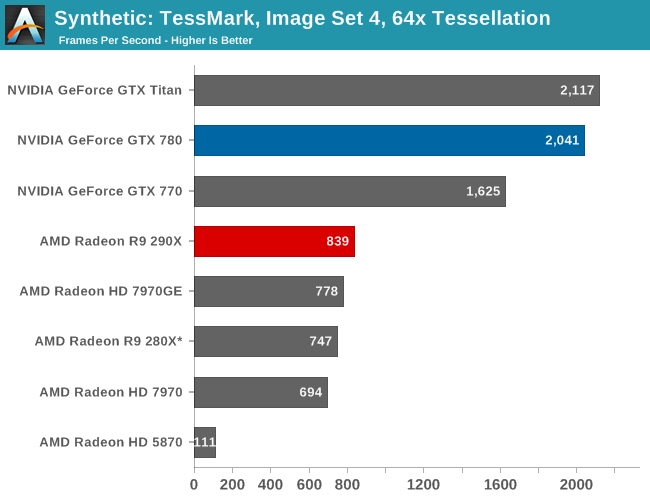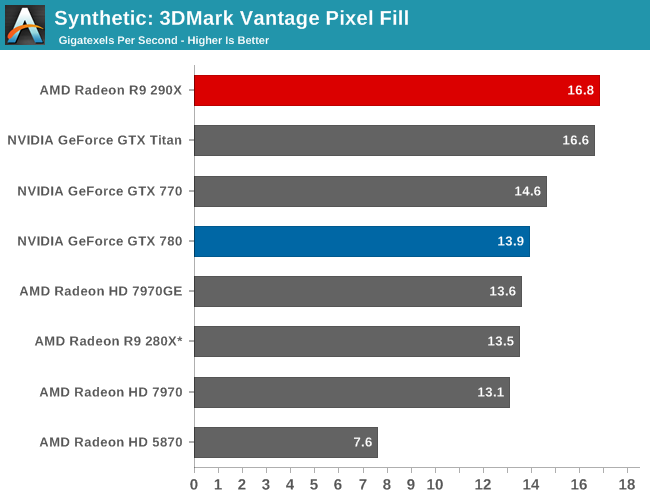The AMD Radeon R9 290X Review
by Ryan Smith on October 24, 2013 12:01 AM EST- Posted in
- GPUs
- AMD
- Radeon
- Hawaii
- Radeon 200
Synthetics
As always we’ll also take a quick look at synthetic performance. The 290X shouldn’t pack any great surprises here since it’s still GCN, and as such bound to the same general rules for efficiency, but we do have the additional geometry processors and additional ROPs to occupy our attention.

Right off the bat then, the TessMark results are something of a head scratcher. Whereas NVIDIA’s performance here has consistently scaled well with the number of SMXes, AMD’s seeing minimal scaling from those additional geometry processors on Hawaii/290X. Clearly Tessmark is striking another bottleneck on 290X beyond simple geometry throughput, though it’s not absolutely clear what that bottleneck is.
This is a tessellation-heavy benchmark as opposed to a simple massive geometry bencehmark, so we may be seeing a tessellation bottleneck rather than a geometry bottleneck, as tessellation requires its own set of heavy lifting to generate the necessary control points. The 12% performance gain is much closer to the 11% memory bandwidth gain than anything else, so it may be that the 280X and 290X are having to go off-chip to store tessellation data (we are after all using a rather extreme factor), in which case it’s a memory bandwidth bottleneck. Real world geometry performance will undoubtedly be better than this – thankfully for AMD this is the pathological tessellation case – but it does serve of a reminder of how much more tessellation performance NVIDIA is able to wring out of Kepler. Though the nearly 8x increase in tessellation performance since 5870 shows that AMD has at least gone a long way in 4 years, and considering the performance in our tessellation enabled games AMD doesn’t seem to be hurting for tessellation performance in the real world right now.
Moving on, we have our 3DMark Vantage texture and pixel fillrate tests, which present our cards with massive amounts of texturing and color blending work. These aren’t results we suggest comparing across different vendors, but they’re good for tracking improvements and changes within a single product family.

Looking first at texturing performance, we can see that texturing performance is essentially scaling 1:1 with what the theoretical numbers say it should. 36% better texturing performance over 280X is exactly in line with the increased number of texture units versus 280X, at the very least proving that 290X isn’t having any trouble feeding the increased number of texture units in this scenario.

Meanwhile for our pixel fill rates the results are a bit more in the middle, reflecting the fact that this test is a mix of ROP bottlenecking and memory bandwidth bottlenecking. Remember, AMD doubled the ROPs versus 280X, but only gave it 11% more memory bandwidth. As a result the ROPs’ ability to perform is going to depend in part on how well color compression works and what can be recycled in the L2 cache, as anything else means a trip to the VRAM and running into those lesser memory bandwidth gains. Though the 290X does get something of a secondary benefit here, which is that unlike the 280X it doesn’t have to go through a memory crossbar and any inefficiencies/overhead it may add, since the number of ROPs and memory controllers is perfectly aligned on Hawaii.










396 Comments
View All Comments
OverclockedCeleron - Thursday, October 24, 2013 - link
That made my day!pattycake0147 - Friday, October 25, 2013 - link
Yes! Comment of the day.TheinsanegamerN - Friday, October 25, 2013 - link
[reply in progress]OverclockedCeleron - Thursday, October 24, 2013 - link
Well done AMD, keep up the good work! Now it's the CPU turn ;).aTaoZ - Thursday, October 24, 2013 - link
Over in the overclocker uk forum, Gibbo is hinting the performance of non-x version in his 290X overclocking review. It is highly possible R9 290 will match GTX780 in performance at an even lower price.steelmilkjug - Friday, October 25, 2013 - link
It's good to see NVidia and AMD jockeying for the high end. Competition always helps keep prices realistic. Everytime I buy GPUs I go through the same mental struggle: Nvidia with better power/temp efficiency (roughly stated I know), AMD with slightly better price/performance ratios, sometimes significantly better. In the end, it always comes down to one thing for me: drivers. NVidia just seems to be more proactive in supporting their products, new drivers seem to come more often, and I feel the affect in games , usually. Less dual card issues, generally and a seemingly broader support of games in general. NVidia is a graphics hardware company specifically. AMD is not. They are a computer hardware company with a graphics department. And it shows. I'm an electrical engineer and I've seen how hard it is to get a job as an NVidia EE. It's a world renowned job, and they only pick the best in the world. I'm not sure AMD is quite as stringent.manicmonday - Friday, October 25, 2013 - link
So you think second tier engineers at AMD created a chip 25% smaller with better performance?SunLord - Friday, October 25, 2013 - link
Did Ryan quit or pass away 1/3 of the way through writing this review other this is pathetic so much for being a top tier review site.piroroadkill - Friday, October 25, 2013 - link
Yep. I gave them a while, some pages have now populated, but there are still too many empty ones. This is pretty poor.These days it seems like Apple gets all the coverage. Well, I couldn't really give a rats ass about massively long Apple articles. After all, Apple just wrap things up (such as GCN, Intel CPUs) into shiny boxes.
I think most of your readership is probably interested in the underlying tech, too.
Da W - Friday, October 25, 2013 - link
Man what do you do for a living? Quit bitching about other people's work, if you're not happy go somewhere else and STFU.